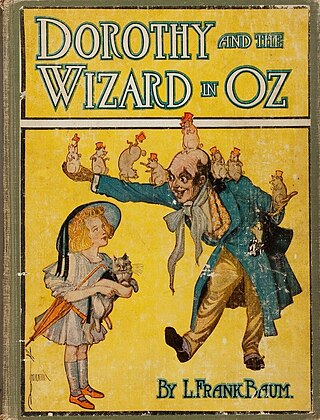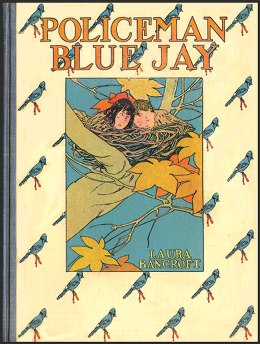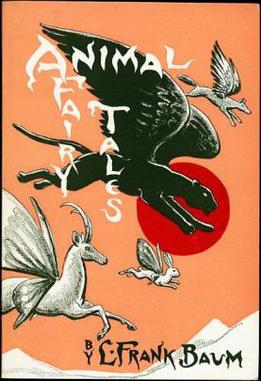Related Research Articles

Lyman Frank Baum was an American author best known for his children's books, particularly The Wonderful Wizard of Oz, part of a series. In addition to the 14 Oz books, Baum penned 41 other novels, 83 short stories, over 200 poems, and at least 42 scripts. He made numerous attempts to bring his works to the stage and screen; the 1939 adaptation of the first Oz book became a landmark of 20th-century cinema.

The Road to Oz: In Which Is Related How Dorothy Gale of Kansas, The Shaggy Man, Button Bright, and Polychrome the Rainbow's Daughter Met on an Enchanted Road and Followed it All the Way to the Marvelous Land of Oz. is the fifth of L. Frank Baum's Land of Oz books. It was originally published on July 10, 1909 and documents the adventures of Dorothy Gale's fourth visit to the Land of Oz.

The Tin Woodman of Oz: A Faithful Story of the Astonishing Adventure Undertaken by the Tin Woodman, Assisted by Woot the Wanderer, the Scarecrow of Oz, and Polychrome, the Rainbow's Daughter is the twelfth Land of Oz book written by L. Frank Baum and was originally published on May 13, 1918. The Tin Woodman is reunited with his Munchkin sweetheart Nimmie Amee from the days when he was flesh and blood. This was a back-story from Baum's 1900 novel, The Wonderful Wizard of Oz.

Dorothy and the Wizard in Oz is the fourth book set in the Land of Oz written by L. Frank Baum and illustrated by John R. Neill. It was published on June 18, 1908 and reunites Dorothy Gale with the humbug Wizard from The Wonderful Wizard of Oz (1900). This is one of only two of the original fourteen Oz books (the other being The Emerald City of Oz, to be illustrated with watercolor paintings.

Princess Ozma is a fictional character from the Land of Oz, created by American author L. Frank Baum. She appears in every book of the Oz series except the first, The Wonderful Wizard of Oz (1900).
Queen Lurline is a fictional character in the Oz books by L. Frank Baum and other authors.

Queen Zixi of Ix, or The Story of the Magic Cloak, is a children's book written by L. Frank Baum and illustrated by Frederick Richardson. It was originally serialized in the early 20th-century American children's magazine St. Nicholas from November 1904 to October 1905, and was published in book form later in 1905 by The Century Company. The events of the book alternate between Noland and Ix, two neighboring regions to the Land of Oz, and Baum himself commented this was the best book he had written. In a letter to his eldest son, Frank Joslyn Baum, he said it was "nearer to the "old-fashioned" fairy tale than anything I have yet accomplished," and in many respects, it adheres more closely to the fairy tale structure than the Oz books.

The Magical Mimics in Oz (1946) is the thirty-seventh in the series of Oz books created by L. Frank Baum and his successors, and the first written by Jack Snow. It was illustrated by Frank G. Kramer. The book entered the Public Domain in the United States, when its copyright was not renewed as required.

The Life and Adventures of Santa Claus is a 1902 children's book, written by L. Frank Baum and illustrated by Mary Cowles Clark.
Michael Patrick Hearn is an American literary scholar as well as a man of letters specializing in children's literature and its illustration. His works include The Annotated Wizard of Oz (1973/2000), The Annotated Christmas Carol (1977/2003), and The Annotated Huckleberry Finn (2001). He considers the three most quintessential American novels to be Moby-Dick by Herman Melville, The Wonderful Wizard of Oz by L. Frank Baum, and The Adventures of Huckleberry Finn by Mark Twain.

American Fairy Tales is the title of a collection of twelve fantasy stories by L. Frank Baum, published in 1901 by the George M. Hill Company, the firm that issued The Wonderful Wizard of Oz the previous year. The cover, title page, and page borders were designed by Ralph Fletcher Seymour; each story was furnished with two full-page black-and-white illustrations, by either Harry Kennedy, Ike Morgan, or Norman P. Hall.

Sky Island: Being the Further Adventures of Trot and Cap'n Bill after Their Visit to the Sea Fairies is a children's fantasy novel written by L. Frank Baum, illustrated by John R. Neill, and published in 1912 by the Reilly & Britton Company—the same constellation of forces that produced the Oz books in the first decades of the twentieth century.

The Enchanted Island of Yew: Whereon Prince Marvel Encountered the High Ki of Twi and Other Surprising People is a children's fantasy novel written by L. Frank Baum, illustrated by Fanny Y. Cory, and published by the Bobbs-Merrill Company in 1903.

Policeman Bluejay or Babes in Birdland is a children's novel written by L. Frank Baum and illustrated by Maginel Wright Enright. First published in 1907, Jack Snow considered it one of the best of Baum's works.

Animal Fairy Tales is a collection of short stories written by L. Frank Baum, the creator of the Land of Oz series of children's books. The stories first received magazine publication in 1905. For several decades in the twentieth century, the collection was a "lost" book by Baum; it resurfaced when the International Wizard of Oz Club published the stories in one volume in 1969.
"A Kidnapped Santa Claus" is a Christmas-themed short story by American writer L. Frank Baum; it has been called "one of Baum's most beautiful stories" and constitutes an influential contribution to the mythology of Christmas.

The Life and Adventures of Santa Claus is a 1985 Christmas stop motion animated television special. It was produced by Rankin/Bass Productions, based on the 1902 children's book The Life and Adventures of Santa Claus by L. Frank Baum, the writer of The Wonderful Wizard of Oz. The special first aired December 17, 1985 on CBS in the United States, and December 24, 1986 on TV Asahi in Japan with the title Santa's Secret and Great Adventure. This was Rankin/Bass's final "Animagic" stop motion production filmed in Japan and later productions would be traditionally animated.
"The Runaway Shadows, or A Trick of Jack Frost" is a twentieth-century fairy tale, a fantasy short story written by L. Frank Baum, famous as the creator of the Land of Oz. The story is one of a small cluster of Baum narratives that involve his fantasy land the Forest of Burzee and its exotic denizens. Arguably, Burzee constitutes Baum's second most important fantasy realm after Oz itself, being employed in his novels The Life and Adventures of Santa Claus (1902) and Queen Zixi of Ix (1905) and several of his short stories, and is referenced in The Road to Oz (1909).

The Life & Adventures of Santa Claus is a 2000 American direct-to-video animated fantasy film created by Mike Young Productions and released by Universal Studios Home Entertainment. It is based on the 1902 L. Frank Baum novel of the same name.
This is a complete bibliography for American children's writer L. Frank Baum.
References
- ↑ Kevin Starr, Material Dreams: Southern California Thought in the 1920s, New York, Oxford University Press, 1991; p. 66. (Not a college newspaper, as is often erroneously reported.)
- ↑ L. Frank Baum, The Runaway Shadows and Other Stories, with an Introduction by C. Warren Hollister, Escanaba, MI, International Wizard of Oz Club, 1980.
- ↑ Hollister, Introduction, The Runaway Shadows and Other Stories, p. 6.
- ↑ L. Frank Baum, The Road to Oz , Chicago, Reilly & Britton, 1907; Chapter 1.
- ↑ The Runaway Shadows and Other Stories, pp. 38-9.